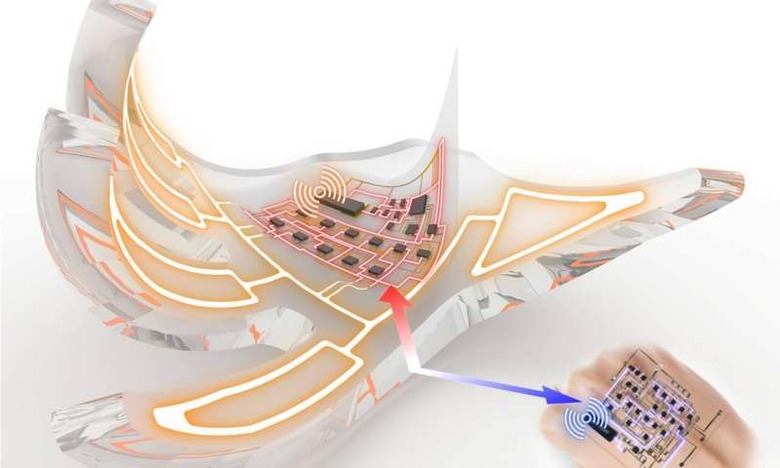E-Skin Made For "Fully Soft Robots"
Researchers are on the verge of creating electronic skin – a component of robots of the future made with "soft" features. Softness here means the opposite of rigidity. The softer the part, the more the part can be bent, molded, and shaped to meet challenges. The problem, said researchers this week, is that existing robots have set of necessary parts that aren't by their nature soft. These researchers presented a "skin-like electronic system" with which the gap between hard and soft can be bridged.
"Despite the body's softness, existing models mostly carry inherent hardness in their driving parts, such as pressure-regulating components and rigid circuit boards. This compliance gap can frequently interfere with the robot motion and makes soft robotic design dependent on rigid assembly of each robot component," said Junghwan Byun et all., "We present a skin-like electronic system that enables a class of wirelessly activated fully soft robots whose driving part can be softly, compactly, and reversibly assembled."
The solution here consists of a set of e-skins, or electronic skins, that use wireless tech to communicate. These skins work with a spatially fragmented circuit configuration, allowing them to stretch in a variety of ways. As you'll see in the tiny video in this article, this means machines will be able to fit themselves into some tight spaces.
This tech is based on print-friendly hybrid electronic technology. Side A works with input sensing, the other for robot activation. The base dimensional component in this e-skin tech is a mere 1.5 mm × 1.5 mm or smaller – so they're really, really good at the limbo, if need be. The e-skin itself is less than 1mm and weighs in at around 0.8g.
This all might remind you of some tech that went semi-viral a few years ago. We did a review of the VivaLnk Digital Tattoo to see how the simple set of NFC-based components fared. The tech in this new e-skin is far more complex, but it has similar roots.

Junghwan Byun was involved in a number of research projects on similar technologies over the past decade. One went by the name "All-Ink-Jet-Printed Wearable Information Display Directly Fabricated onto an Elastomeric Substrate," another "Fully printable, strain-engineered electronic wrap for customizable soft electronics." In May of 2017 a paper was published by a team with Byun called "Key Enabling Technology for Stretchable LED Display and Electronic System." This business didn't just pop up out of nowhere – and it's not going away any time soon. Soft robots are coming! See more in our Soft Robotics tag portal right this minute!
Images and videos in this article come from the Soft Robotics Research Center, Seoul National University. They're captured with FLIR technology. FUN FACT: You can use FLIR heat-sensing camera tech in a smartphone right this minute, thanks to CAT – in the CAT S61 smartphone.
For more information on this subject, see the research paper "Electronic skins for soft, compact, reversible assembly of wirelessly activated fully soft robots" as published in the 18th issue of Science Robotics on May 30, 2018. This paper was authored by Junghwan Byun, Yoontaek Lee, Jaeyoung Yoon, Byeongmoon Lee, Eunho Oh, Seungjun Chung, Takhee Lee, et. all, and can be found with code DOI: 10.1126/scirobotics.aas9020 as of the 30th of May, 2018.
